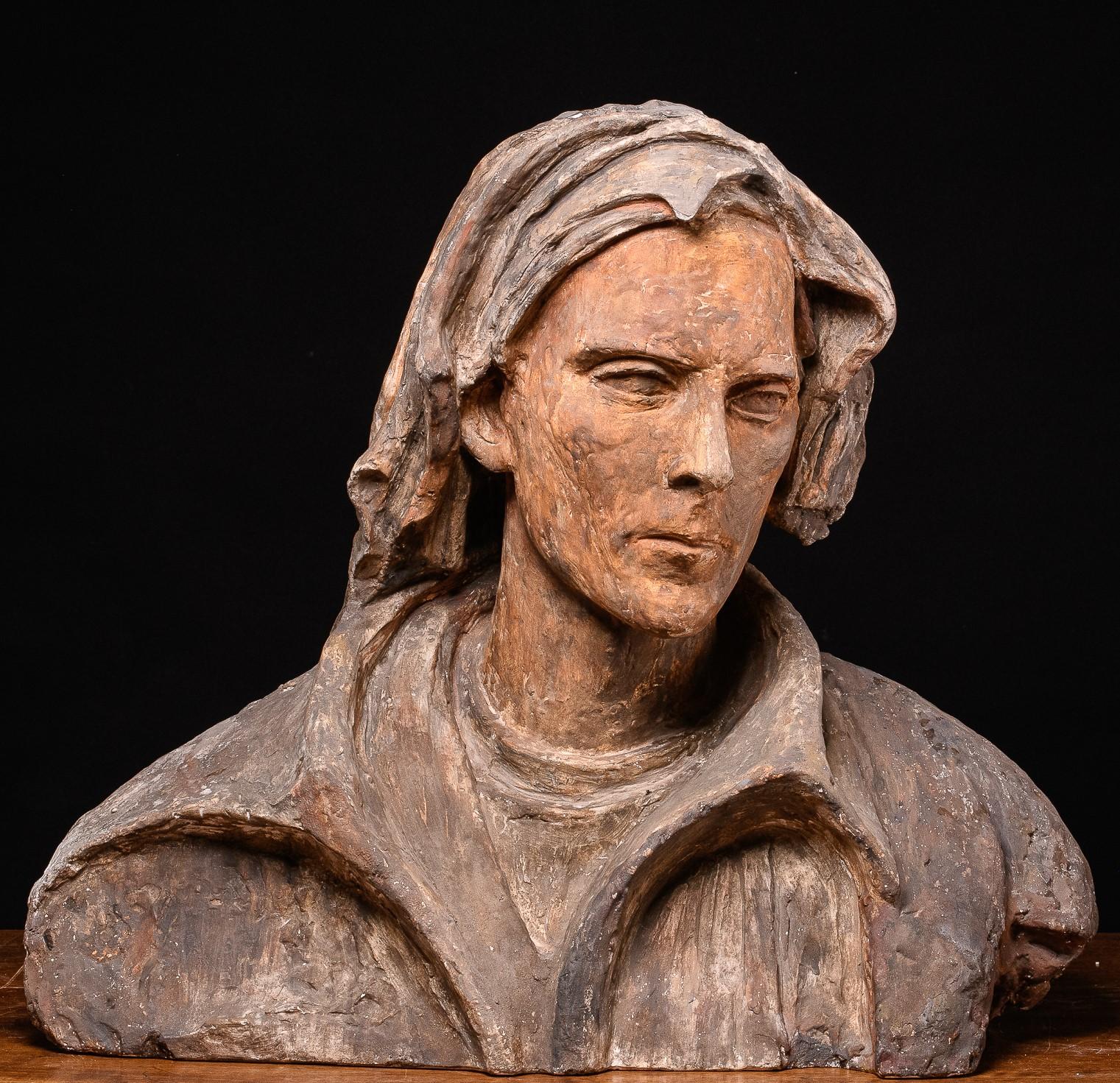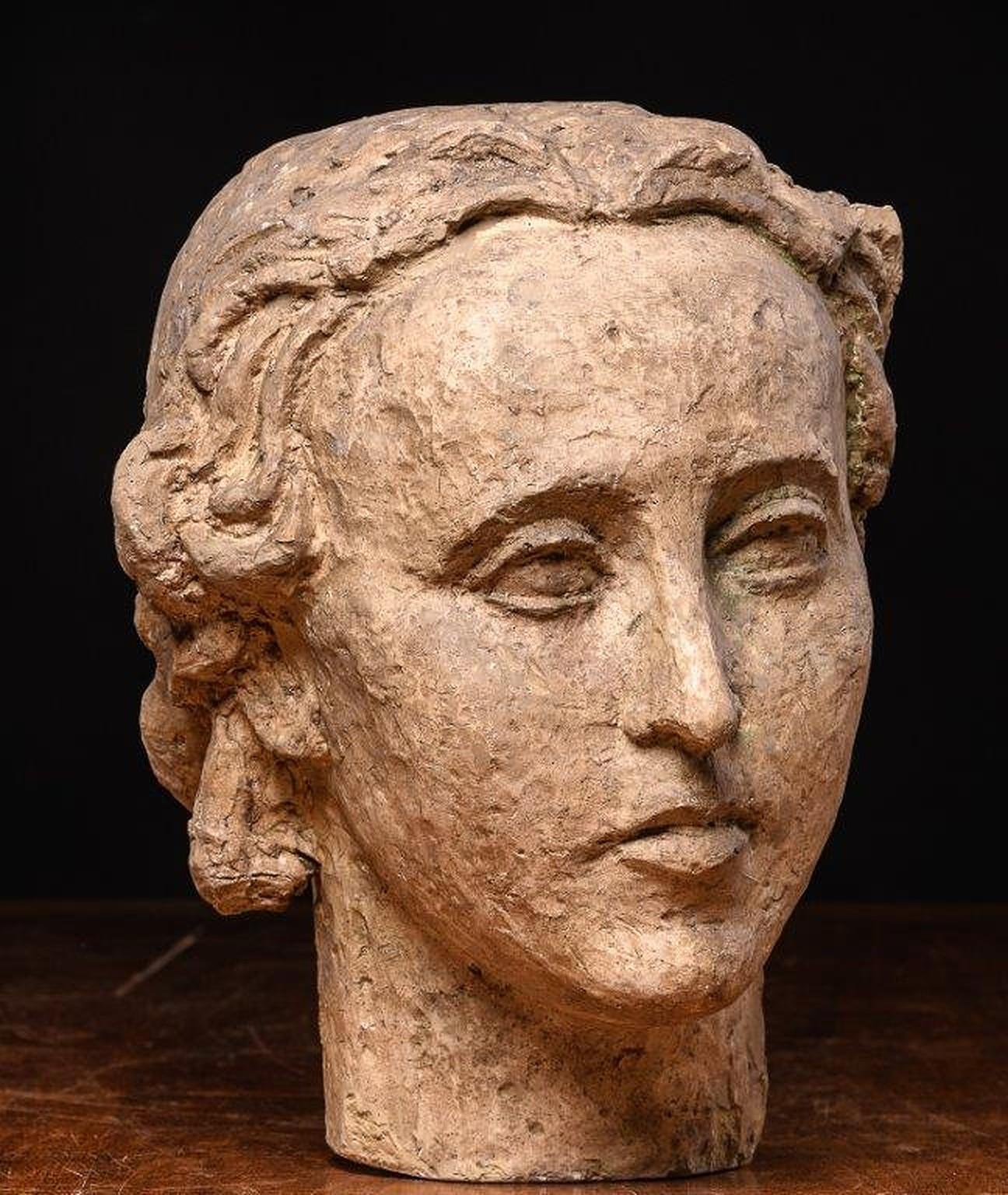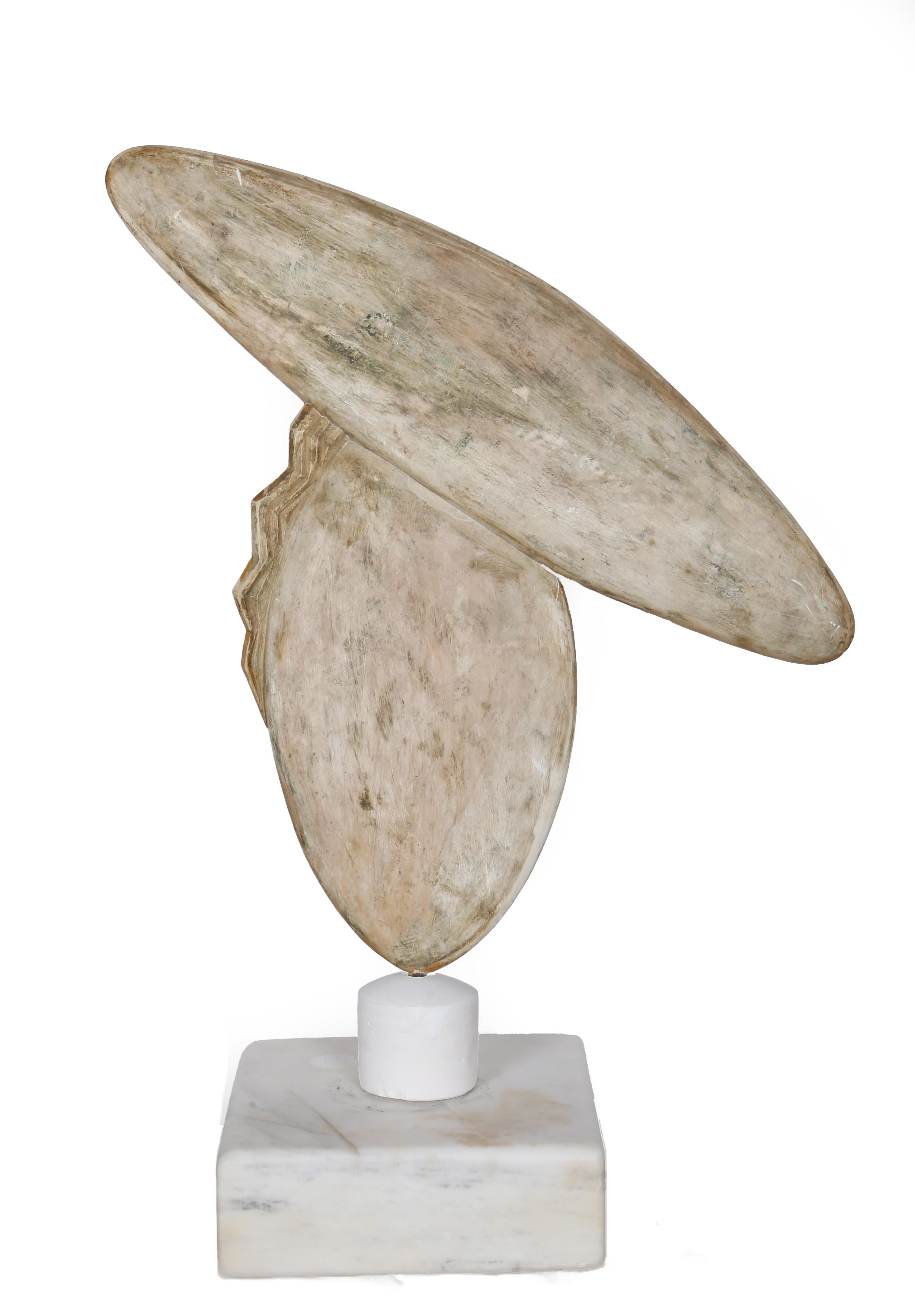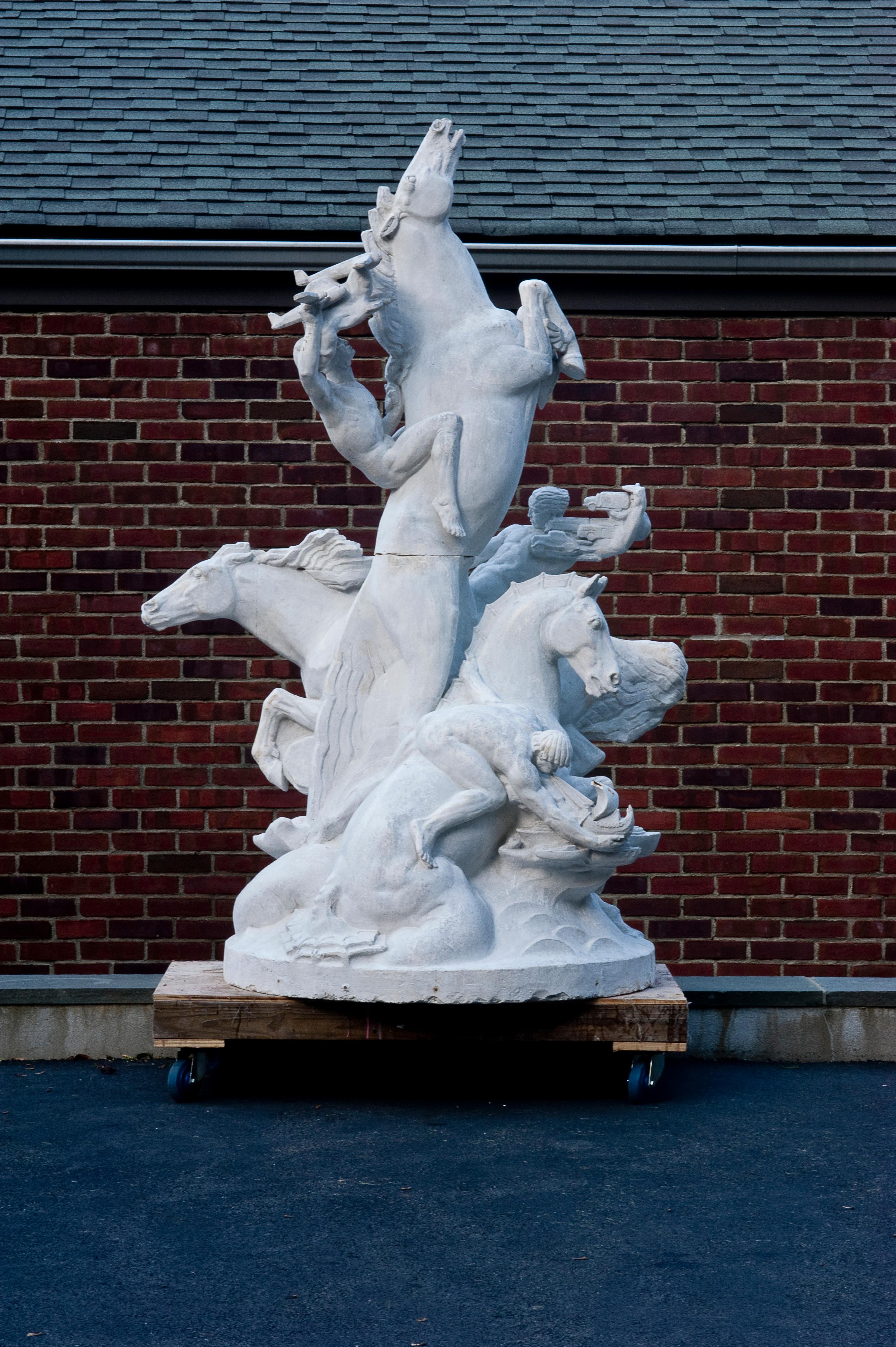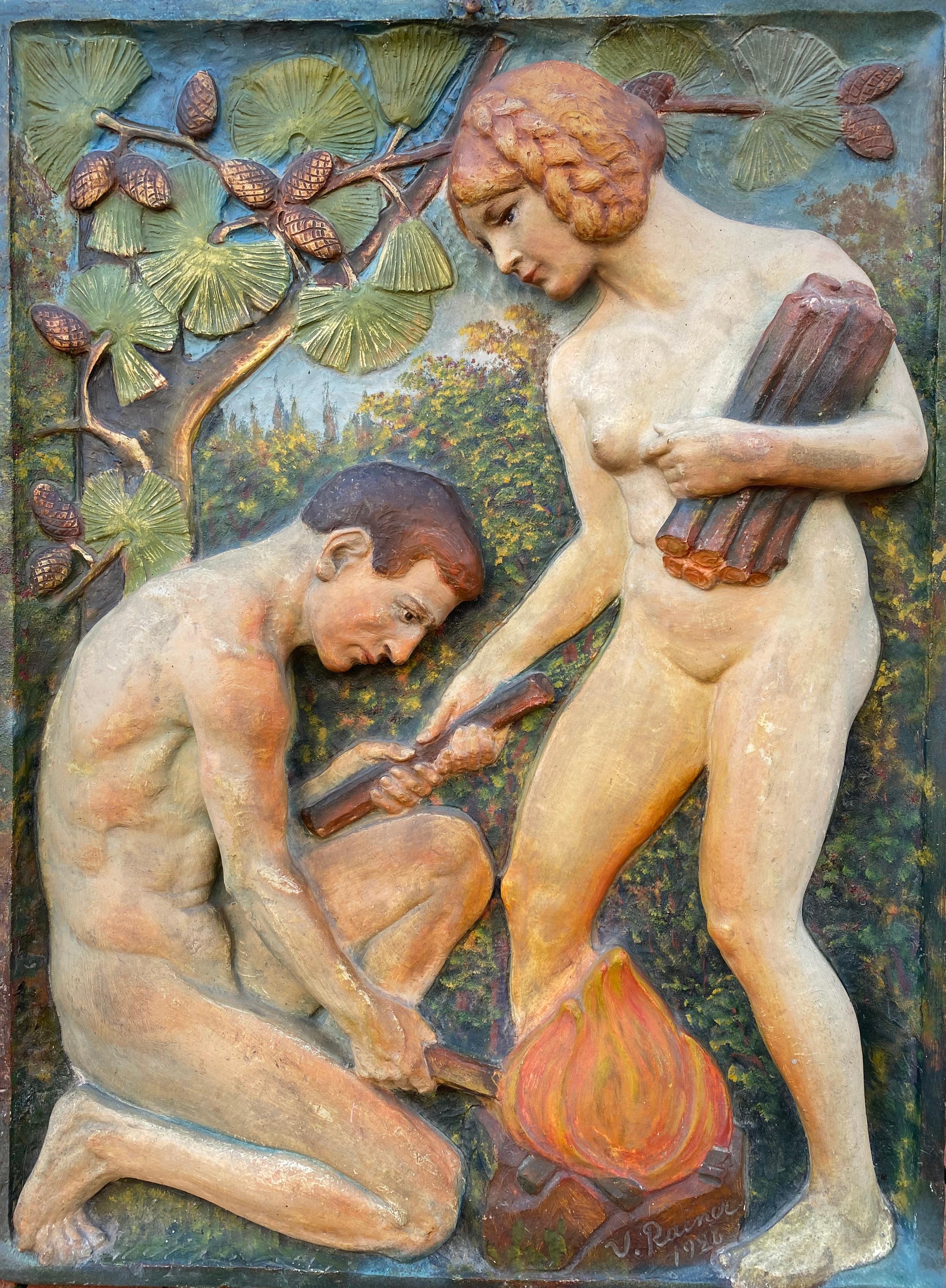Items Similar to The Falconer, Art Deco British Plaster Sculpture by Richard Garbe RA
Want more images or videos?
Request additional images or videos from the seller
1 of 4
Richard GarbeThe Falconer, Art Deco British Plaster Sculpture by Richard Garbe RA1932
1932
About the Item
RICHARD GARBE, RA
(1876-1957)
The Falconer
Signed and dated on the reverse: Richard Garbe, ARA / 1932
Patinated plaster
49.5 cm., 19 ½ in. high
Provenance:
By descent in the family of the artist.
A photograph of The Falconer is in the collection of the Victoria & Albert Museum, London, ex collection of William Kineton Parkes.
Garbe was born in Dalston, London, the son of Gustave Garbe, a carver of ivory and manufacturer of tortoiseshell fancy goods, to whom he was apprenticed. He later studied at the Central School of Art and at the Royal Academy Schools. He began exhibiting at the Royal Academy in 1908. He taught sculpture at the Central School 1901-29 and was Professor of Sculpture at the Royal College of Art, 1929-46. He was elected an Academician at the Royal Academy of Arts in 1929 and full Academician in 1936. In 1929 he was elected a Fellow of the Royal British Society of Sculptors, while in 1938 he was elected as a Master of the Art Workers’ Guild. He is represented in many major public collections including the Tate Gallery and Victoria & Albert Museum.
- Creator:Richard Garbe (1876 - 1957, British)
- Creation Year:1932
- Dimensions:Height: 19.49 in (49.5 cm)Width: 9.45 in (24 cm)Depth: 5.12 in (13 cm)
- Medium:
- Movement & Style:
- Period:
- Condition:
- Gallery Location:London, GB
- Reference Number:

About the Seller
4.9
Vetted Seller
These experienced sellers undergo a comprehensive evaluation by our team of in-house experts.
Established in 2004
1stDibs seller since 2018
50 sales on 1stDibs
Typical response time: 15 hours
- ShippingRetrieving quote...Ships From: Banbury, United Kingdom
- Return PolicyA return for this item may be initiated within 14 days of delivery.
More From This SellerView All
- Richard Garbe - Helios - Early 20th Century British patinated plaster sculptureBy Richard GarbeLocated in London, GBRICHARD LOUIS GARBE, RA (1876-1957) Helios Signed and dated 1929 Plaster with patinated surface 86 cm., 33 ¾ in. high Garbe was born in Dalston, London, the son of Gustave Garbe,...Category
Early 20th Century Art Deco Nude Sculptures
MaterialsPlaster
- Edward Carter Preston - Athena - 20th Century British Plaster Sculpture FigureLocated in London, GBEDWARD CARTER PRESTON (1885-1965) Athena Signed: E CARTER PRESTON Bronzed plaster 59 cm., 23 ¼ in. high Edward Carter Preston is best known as the designer of the bronze memorial...Category
Early 20th Century Realist Figurative Sculptures
MaterialsPlaster
- Alfreda, The Artist's Daughter - British 1950s plaster bust by Richard GarbeBy Richard GarbeLocated in London, GBRICHARD LOUIS GARBE, RA (1876-1957) Alfreda, The Artist’s Daughter Signed and dated 1956 Plaster with patinated surface on a wooden base 30 cm., 11 ¾ in. high Provenance: Gifted ...Category
1950s Realist Figurative Sculptures
MaterialsPlaster
- St CeciliaLocated in London, GBD. BRUCCIANI & CO (19th Century) St Cecilia Polychrome painted plaster bust with mould lines visible (probably later painting) 47 cm., 18 ½ in. high Dom...Category
1870s Renaissance Figurative Sculptures
MaterialsPlaster
- Gilbert Ledward - 1930s Watercolour Design for a Decorative Sculptural FriezeLocated in London, GBGILBERT LEDWARD, RA, PRBS (1888-1960) Tennis, Golf, Shooting, Ice-Skating, Dreaming – Proposed Design for Decorative Frieze in the Italian Drawing Room at Eltham Palace, commissioned by Stephen Courtauld Signed and dated July 9th 1933 Watercolour and pencil 12.5 by 49.5 cm., 5 by 19 ½ in. (frame size 36 by 67 cm., 14 ¼ by 26 ¼ in.) Exhibited: The artist’s daughter; London, The Fine Art Society, A Centenary Tribute, Feb 1988, no. 43. Gilbert Ledward was born in London. He was educated at St Mark’s College, Chelsea. In 1905 he entered the Royal College of Art to study sculpture under Edouard Lanteri and in 1910 he entered the Royal Academy Schools. In 1913 he won the Prix de Rome for sculpture, the Royal Academy’s travelling award and gold medal, which allowed him to travel in Italy until the outbreak of the Wold War I. During the war he served as a lieutenant in the Royal Garrison Artillery and was appointed as an official war artist in 1918. Following the war he was largely occupied as a sculptor of war memorials including the Guards Division memorial in St James’s Park and the Household Division’s memorial in Horse Guards Parade. In 1934, supported by Eric Gill and Edwin Lutyens, he established a company called Sculptured Memorials and Headstones, which promoted better design of memorials in English churchyards. His war memorials after World War II include one in Westminster Abbey to the Submarine Service, Commandos and Airborne Forces. Ledward was Professor of Sculpture at the Royal College of Art (1927-1929) and in 1937 was elected at Royal Academician. He became President of the Royal Society of British Sculptors and a trustee of the Royal Academy. The present work is a design for an intended decorative frieze for the Italian Drawing Room of Eltham Palace. In 1935 the remains of the medieval royal palace of Eltham was rescued from decay by Stephen and Virginia Courtald who built an ultra modern Art Deco house to adjoin the existing Great Hall. They employed the architects John Seeley and Paul Edward Paget and the fashionable Mayfair interior designer the Marchese Peter Malacrida to design the strikingly glamorous 1930s interiors of the new house. The dramatic entrance hall was created by the Swedish designer Rolf Engstromer...Category
1930s Art Deco Figurative Sculptures
MaterialsWatercolor
- Mrs Samuelson's Baby Angel - Contemporary British Bronze bust by Nicola HicksBy Nicola HicksLocated in London, GBNICOLA HICKS, MBE (Born 1960) Mrs Samuelson’s Baby Angel Signed with initials and numbered 1/9 Bronze 30 cm., 11 ¾ in. high Provenance: Flowers East, London. Exhibited: London,...Category
Early 2000s Figurative Sculptures
MaterialsBronze
You May Also Like
- Sculptured polychromed Male modelled Bust from artist workshop.Located in brussel, BEGustave Fontaine (Etterbeek 1877-1952 Brussels) was a sculptor–painter. He took courses in Saint-Josse-ten-Noode and continued his training at the Academy of Brussels and with the sculptor Julien...Category
20th Century Art Deco Figurative Sculptures
MaterialsPlaster
- Sculptured polychromed Female modelled Head from artist workshop.Located in brussel, BEGustave Fontaine (Etterbeek 1877-1952 Brussels) was a sculptor–painter. He took courses in Saint-Josse-ten-Noode and continued his training at the Aca...Category
20th Century Art Deco Figurative Sculptures
MaterialsPlaster
- Plaster Sculpture Relief Art Deco Plaque WPA Artist Peace Swords to PloughsharesBy George AaronsLocated in Surfside, FLSize includes wood mounting. George Aarons (born Gregory Podubisky, in St. Petersburg, Russia, 1896 - died in Gloucester, Massachusetts 1980) was a distinguished sculptor who lived and taught in Gloucester, Massachusetts, for many years until his death in 1980. He had, many students in the area and he designed Gloucester's 350th Anniversary Commemorative Medal. Aarons moved from Russia to the United States when he was ten. His father was a merchant. He began taking drawing classes during evenings at Dearborn Public School in Boston as a teenager and went on to study at the Boston Museum of Fine Arts in 1916. Aarons later moved to New York City to study with Jo Davidson, and other Paris-trained masters at the Beaux-Arts Institute. He eventually returned to the Boston area and established studios in Brookline and Gloucester, Massachusetts. During his lifetime, he was recognized internationally and won several prestigious awards. Aarons had studios in Brookline, Massachusetts and Gloucester, Massachusetts where he produced large bronze and marble figures and wood carvings. He produced several projects for the Works Progress Administration including a group of three figures for the Public Garden (Boston), a longshoreman, fisherman and foundry worker, as well as a large relief (1938) for the South Boston Housing Project and façade of the Baltimore Hebrew Congregational Building (1956). His works are at the Museum of Art in Ein Harod, Israel; Fitchburg Art Museum in Massachusetts, Musée de St. Denis in France; Hilles Library at Radcliffe College in Cambridge, Massachusetts; and Hillel House at Boston University in Massachusetts. He did reliefs for Siefer Hall at Brandeis University in Waltham, Massachusetts (1950); Edward Filene (the founder of Filene's Department Store and a philanthropist) on the Boston Common; Fireman's Memorial in Beverly, Massachusetts; a memorial to Mitchell Frieman in Boston; the U.S. Post Office in Ripley, Mississippi; and at the Cincinnati Telephone Building; the Combined Jewish Philanthropies building in Boston (1965); and a commemorative medal for the 350th Anniversary of the City of Gloucester, Massachusetts (1972). Characteristic of his era, George Aarons was among the foreign-born American sculptors of the early 20th century who started their careers as academicians and evolved into modernists and increasingly abstract artists. Over thirty pieces spanning the length of this sculptor's career were featured in this exhibition, including work in various medium bronze, wood and original plasters. Like his contemporaries, Aarons experimented with direct carving in wood, and he was one of the few academically trained sculptors who consistently cut his own works in marble. His early work was classically inspired figurative work, along with sensitive portraits. Some of his most powerful sculpture comes from his middle period, when he worked through his emotional pain following the global realization of the Jewish Holocaust. He depicted humanity deep anxiety over this tragedy with figures that are at once symbolically charged and movingly beautiful. Aarons late work consists of radically simplified forms that continue to reference the human form and often are carved directly in wood and stone. Aarons summered and taught classes on Cape Ann for many years before moving to Gloucester full-time with his wife about 1950. While Aarons is best known locally for his domestic-scale works, he also executed numerous monumental, public commissions that can be found throughout the United States in cities such as Washington, D.C.; Baltimore, Maryland; and Cincinnati, Ohio; as well as in France and Israel. As noted in a Gloucester Daily Times Article, Aarons wanted his sculptures to honor the struggles and nobility of people and rail against the evil done against them. And that was why, even as his work grew more and more abstract, stylized and simplified, he never left behind the form of the human figure that had been his focus from his earliest works. Aarons told the Gloucester Daily Times in September 1954 that he found it hard to remember at just what age he started studying art, but he recalled that the nude model had to partially dress when he was in class because he was so young. He initially studied painting and drawing at the museum school, but he once said he became fascinated by sculpture when he met an established sculptor at the Copley Society in Boston who invited Aarons to his studio and offered him some clay to "play around" with. After he graduated, he apprenticed under sculptors Richard Brooks, Robert Baker and Solon Borglum. He worked as a carpenter, shipbuilder, dishwasher and chimney sweep. He fashioned architectural decorations, including figures for fountains and now and then a few commissioned portraits. He returned to Boston by the early 1920s and began to exhibit his own works and get commissions for portraits, fountains and reliefs. His sculptures from this time are dreamy and romantic in the realistic, academic style of the time. A painted portrait of the young Aarons that is included in the North Shore Arts Association exhibit shows a determined fellow with dark brown hair, a suit and bow tie. However, in 1922, this determined young artist was living with his parents on Calder Street in Dorchester. In the 1930s, Aarons adopted the streamlined, monumental style of the socialist works of the time. Aarons made money, as he would all his life, from commissions, selling his personal work and teaching sculpture, but the Depression of the 1930s was tough for everyone. So Aarons found work though the federal Works Progress Administration, one of Franklin Roosevelt's New Deal programs. He received his first major commission when he was asked to create a public sculpture for the South Boston Harbor Village public housing project around 1937. He was elevated to the position of supervisor for the project and received a corresponding $5 pay increase to make his weekly salary $32. The raise convinced him he was fit to marry and he proposed to Gertrude Band, an attractive brunette dancer whom he had been dating for more than a year. They were married before the Harbor Village project was dedicated on Labor Day 1938. Aarons' design featured a brawny, larger-than-lifesize fisherman, longshoreman and a laborer flanked by a boy and girl at either end to portray the children who would live in the apartments. Aarons elected to do the piece in cast stone to employ carpenters and laborers as well as craftsman for a total of 10 men. In his sculpture, Aarons focused more and more on the theme of oppressed people as he worried about the spread of fascism and Nazism during the 1930s, World War II and after. He had done pieces during the mid-1930s about the oppression of African-Americans, including "Negro Head," which is in the North Shore Art Association retrospective. After the war, he also delved into Jewish themes and became increasingly known as an important Jewish artist, leading to commissions from Jewish organizations across the country and abroad. "He gets into raw emotion. Some people describe him as an expressionist because of the emotion (in his work)," Reynolds says. But Aarons, also sculpted sensual sexual nudes...Category
20th Century Art Deco Figurative Sculptures
MaterialsPlaster, Wood
- Carmen, Washington: Plaster Sculpture with Marble Base by Constantin AntonoviciBy Constantin AntonoviciLocated in Long Island City, NYA minimalist depiction of a woman in a large hat by Constantin Antonovici. This white marble sculpture is composed almost entirely of two colliding ovals, with a few ridges visible o...Category
1970s Art Deco Abstract Sculptures
MaterialsMarble
- 1, 000 piece Museum Quality Collection of Art & Objects from NYC 1939 Worlds FairBy Chester BeachLocated in New York, NY1,000 piece Museum Quality Collection of Art & Objects from NYC 1939 Worlds Fair is available for sale. This sculpture, "Riders of the Elements," is the original 7' plaster maquette from the NYC 1939 World's Fair by Chester Beach...Category
1930s Art Deco Figurative Sculptures
MaterialsCanvas, Oil, Photographic Paper, Plaster
- “Adam and Eve”Located in Southampton, NYVery rare Art Deco three dimensional terracotta sculpture of Adam and Eve by the Austrian artist, Virgil Rainer. Hand painted by the artist. Signed bott...Category
1920s Art Deco Figurative Sculptures
MaterialsTerracotta, Plaster
Recently Viewed
View AllMore Ways To Browse
Vintage Art Deco Art Deco
Art Deco Collection
Art Deco London
Art Deco In London
Art Deco School
Ivory Art Deco
1938 Art Deco
1936 Art Deco
Plaster Collection
Collection Of Plasters
Figurative Plaster Sculptures
British Art Deco
Art Deco 1932
Sculpture Worker
The Worker Sculpture
Sculptures Of Workers
Deco Plaster
Art Deco Plaster
